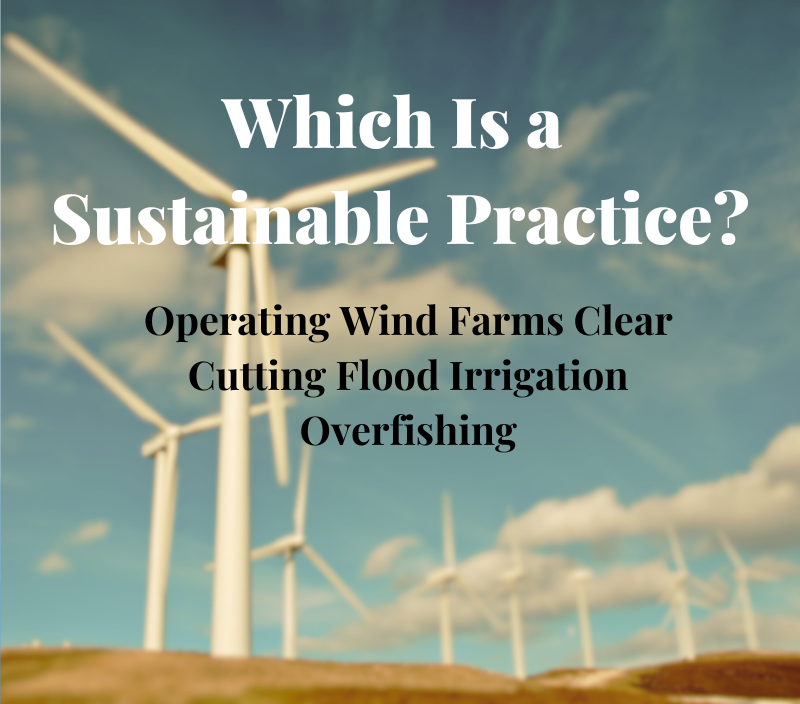As our world fights the consequences inflicted by global warming and environmental degradation, so sustainability has become paramount. Discover which is a sustainable practice with our expert insights and practical tips.
Sustainable practices are those that can be maintained over the long term without causing harm to the environment or depleting natural resources.
Now, we will delve into four practices – wind farms, clear-cutting, flood irrigation, and overfishing – and evaluate their environmental and economic feasibility.
Which is a Sustainable Practice? 4 Impactful Practices
Here are four impactful sustainable practices:
Operating Wind Farms
Wind power stands as a renewable energy resource that produces electricity through the employment of wind turbines. Wind farms, which encompass numerous wind turbines, work collectively to generate electricity, catering to the energy needs of residences and businesses.
Its power eco-friendliness highlights its ability to generate energy without emitting pollutants, thus minimizing its ecological footprint. While the establishment of wind turbines might necessitate the clearing of certain areas, this impact is comparably modest in relation to energy sources such as coal, oil, and natural gas.
After the installation of turbines, the land retains its functionality for activities such as agriculture, grazing, and various other functions. Wind Farms have emerged as a promising alternative to fossil fuels, harnessing the power of wind to generate electricity.
This practice is undeniably sustainable. Wind energy is renewable, emits no greenhouse gases during operation, and has a minimal ecological footprint. Wind farms can coexist with agricultural land and even benefit local communities through job creation and lease payments to landowners.
Clear Cutting
Clear-cutting, a common forestry technique, involves the complete removal of trees within a designated area. This method is frequently employed to create space for new vegetation or to rapidly gather timber.
The environmental repercussions of clear-cutting are profound, encompassing issues like soil erosion, diminished biodiversity, and the disruption of wildlife habitats. Additionally, this practice exacerbates climate change by reducing the number of trees responsible for absorbing carbon dioxide.
Due to its potential for enduring ecological harm, clear-cutting is not deemed sustainable. Although reforestation endeavors may alleviate some of the consequences, the loss of biodiversity and habitats remains a challenge to adequately address.
Flood Irrigation

Flood irrigation involves inundating fields with water to nourish crops. People commonly use this technique in regions with scarce rainfall or limited water availability. Despite its effectiveness in promoting crop growth, flood irrigation can contribute to adverse outcomes like soil erosion, waterlogging, and heightened salinity levels.
Flood irrigation lacks sustainability as it can degrade soil quality, deplete water resources, and ultimately reduce crop productivity. To tackle these issues, farmers can embrace alternative, sustainable irrigation methods like drip irrigation or sprinkler systems. These methods aim to conserve water and mitigate environmental impact.
Overfishing
Overfishing transpires when fish populations are caught at a pace that surpasses their capacity for reproduction. This unsustainable practice can trigger the depletion of fish stocks and the depletion of prized seafood varieties. The environmental ramifications of overfishing are substantial as well, disrupting food chains and impacting marine ecosystems.
Considering its potential to cause lasting ecological harm and deplete essential food sources, we do not view overfishing as a sustainable approach. Adopting sustainable fishing methodologies, which encompass measures like establishing harvest limits, safeguarding habitats, and refraining from destructive fishing techniques, becomes essential to uphold robust fish populations and securing a lasting food source.
Comparing Sustainability Factors
Assessing sustainability involves resource availability, environmental impact, economic viability, and societal benefits. Wind farms excel in low environmental impact while clear-cutting and flood irrigation need careful management to reduce negatives. Overfishing poses a significant threat, demanding urgent action to protect marine ecosystems.
The Importance of Long-Term Thinking
Sustainability requires thinking beyond immediate gains. It involves understanding that short-term benefits should not come at the expense of long-term well-being. Sustainability ensures a healthy planet for present and future generations, leaving a legacy of responsible stewardship.
Which is a Sustainable Practice? – Final Verdict
Among the four options we analyzed, operating wind farms emerged as the most environmentally sustainable approach. While there might be instances where clear-cutting is unavoidable, its potential for enduring ecological consequences renders it less sustainable.
Flood irrigation has the downside of causing soil deterioration and dwindling water resources. Simultaneously, overfishing poses a substantial threat to marine ecosystems and the stability of the food chain. It remains crucial for us to persist in the advancement and embrace of sustainable methodologies to safeguard our environment, guaranteeing a viable future for the upcoming generations.
Must Read
- The Top 5 Benefits of Sustainable Manufacturing for Your Business
- Sustainable Fashion: Embracing Eco-Friendly Choices For A Stylish Future
- Transforming Your Building’s Exterior: Sustainable Design Ideas
- Sustainable Hunting: Balancing Conservation and the Pursuit of Game
Frequently Asked Questions (FAQs)
Are wind farms completely impact-free on the environment?
Wind farms have a relatively low ecological footprint, but they can pose challenges such as bird collisions and visual impacts on landscapes.
Why is overfishing such a pressing issue?
Overfishing disrupts marine ecosystems, threatens biodiversity, and jeopardizes the livelihoods of millions who depend on fishing.
Can flood irrigation be made sustainable?
Yes, sustainable flood irrigation involves implementing efficient water management techniques, preserving soil health, and preventing water wastage.
What role does reforestation play in clear-cutting sustainability?
Reforestation helps mitigate the negative impacts of clear-cutting by restoring ecosystems, enhancing biodiversity, and preventing soil erosion.
How can individuals contribute to sustainability?
Individuals can adopt eco-friendly practices, support sustainable products, advocate for responsible policies, and raise awareness about the importance of sustainability.







